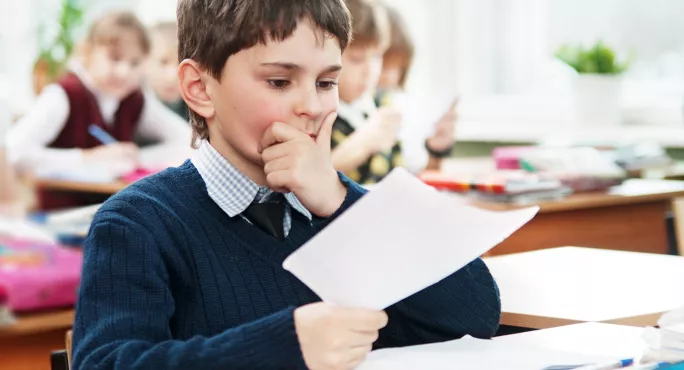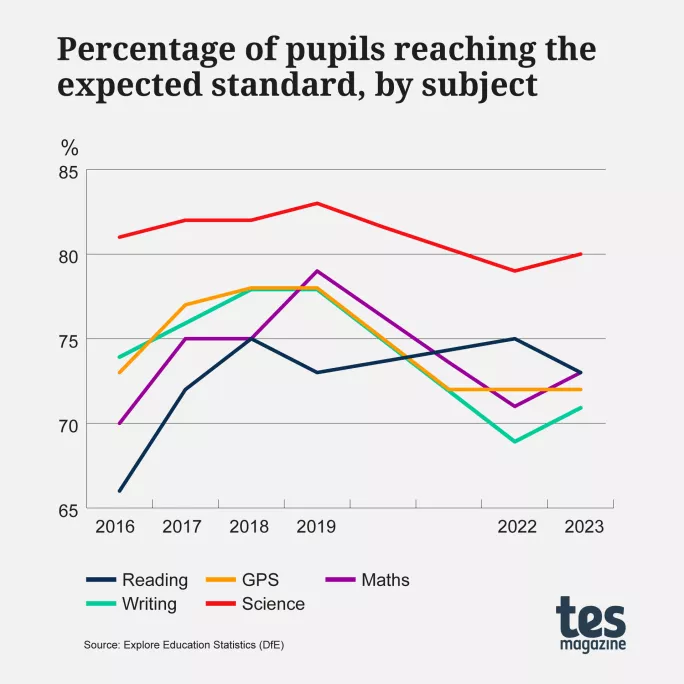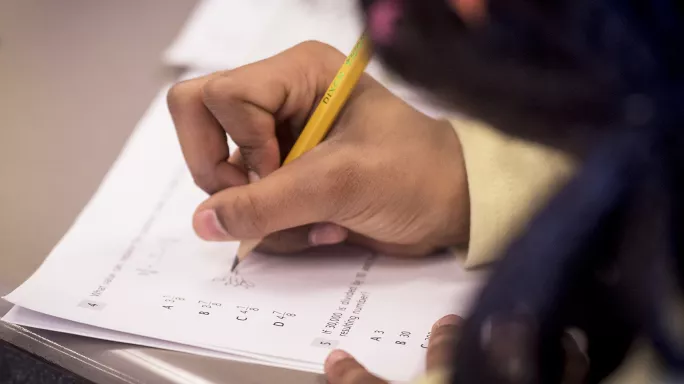
Sats results 2023: No rise towards pre-Covid levels

The proportion of key stage 2 pupils reaching the expected standard in all three areas of reading, writing and maths is unchanged from last year, showing no recovery to pre-Covid levels.
Overall, 59 per cent of Year 6 pupils met the expected standard in all three areas - matching 2022’s “disappointing” results.

This year, the proportion of pupils reaching the expected standard in reading attainment fell from 75 per cent in 2022 to 73 per cent.
The proportion of pupils meeting the expected standard in writing was 71 per cent - a rise of two percentage points from 2022 (69 per cent) but still far below the 2019 figure of 78 per cent.
And the proportion of pupils reaching the expected standard in maths rose to 73 per cent, compared with 71 per cent in 2022.

Huge fall in KS2 reading pass marks
The Department for Education also published the thresholds for reaching the expected standard for KS2 reading, maths and grammar, punctuation and spelling (GPS) tests this morning.
In the reading test, the threshold has fallen from 29 out of 50 in 2022 to 24 this year.
The fall comes after months of concern voiced by leaders who warned that the paper left even the most able pupils “broken” and in tears.
Tes revealed last month that schools minister Nick Gibb had been told that the reading paper was not more difficult than previous years’ assessments.
In maths, the 2022 threshold of 58 out of 110 has this year been dropped to 56.
The threshold for the GPS test was raised from 35 out of 70 to 36.
More on Sats 2023:
- Why this year’s Sats reading paper was so difficult
- Cutting lost papers ‘key priority’ this year, says STA
- Reading paper not more difficult, Gibb told
Commenting on the fall in KS2 reading pass marks this year, Paul Whiteman, general secretary of the NAHT school leaders’ union, said that the move was a “significant and clear recognition that this was a more challenging test for children”.
“It validates what school leaders were saying and it is a real shame that the department was not willing to acknowledge this earlier.”
The DfE previously said that given the interest in this year’s reading test, Mr Gibb asked the Standards and Testing Agency (STA) for their assessment of the relative difficulty of this year’s test and the agency had confirmed that the content was “at the appropriate level of difficulty”.
DfE extends reading framework to key stage 3
Following this year’s Sats results, the government has extended its non-statutory reading framework guidance to cover both key stage 2 and key stage 3.
With results indicating there has been no recovery following the disruption caused by the pandemic, the guidance that previously covered Reception and key stage 1 will now cover pupils up to the age of 14.
The DfE has also announced a review of how writing is being taught in schools.
- Find out more about the extended reading framework
Schools made to wait for results
School leaders were left frustrated this morning as they tried to access their schools’ Sats results via the Primary Assessment Gateway (PAG).
Primary heads reported being unable to access the site despite assurances from the STA that there would be no repeat of the issues that occurred last year.
Sarah Hannafin, head of policy at the NAHT school leaders’ union, said: “It’s beyond belief that for the second successive year, schools have had issues logging into the PAG system, which they use to access results.”
How are Sats scores generated?
Pupils’ Sats marks are converted from a raw score (the total number of marks that a pupil received from their Sats tests) to something called a “scaled score”.
This means that the mark is processed to account for any variations in difficulty that have occurred between assessment year on year. This makes it possible to compare the performance of different cohorts of pupils across different years.
A scaled score of 100 or more means that the pupil has met the expected standard.
If a school believes that a pupil’s mark is incorrect, or that there has been a clerical error, it can apply for a review of marking.
For pupils who do not meet the expected standard in Year 6, there is a literacy and numeracy catch-up premium given to state-funded schools (including special schools and alternative provision settings) to provide additional funding for support in reading and/or maths.
‘Schools are straining every sinew’
Dr Mary Bousted, joint general secretary of the NEU teaching union, said that the results published this morning confirmed that primary schools “are still deeply affected by the pandemic”.
Tiffnie Harris, primary specialist at the Association of School and College Leaders, also said the impact of the pandemic “can still be seen in these results”.
She added: “Schools are straining every sinew to improve results and we appeal to the government to support them by urgently addressing the national crisis caused by teacher shortages and inadequate funding.”
However, Ms Harris said it was “extremely difficult to raise standards when schools are struggling to put a qualified teacher in front of every class” and she warned that the government’s target of 90 per cent of pupils achieving the expected standard in reading, writing and maths “is a pipe dream in these circumstances”.

Jon Andrews, head of analysis at the Education Policy Institute, said: “Although the immediate disruption of the pandemic has passed, the impact it had on younger cohorts may remain with us for some years yet”.
Mr Gibb said: “We know that pupils have had their education disrupted due to the pandemic which is why following on from our success in the Progress in International Reading Literacy Study, it is encouraging to see attainment levels improving in some key subjects.
“Our National Tutoring Programme has been crucial in helping those pupils most in need of support and our reforms - including the focus on phonics - are helping to ensure more children leave primary school with a secure grasp of reading and writing.
“Literacy and numeracy are the cornerstones of a world-class education and that is why we have invested £60 million in our English Hubs programme and £100 million in our Maths Hubs programme to build children’s literacy, speaking and numeracy skills”.
Recent Sats controversy
Following the widespread unhappiness with this year’s KS2 Sats reading paper, schools minister Nick Gibb said he would review the matter.
In addition, Capita, which was in charge of the marking of this year’s primary assessment papers, had to delay the marking process by a week.
The firm was then criticised for “chaos” surrounding marker training.
- Find the latest news on exams and assessment
What made the 2023 Sats reading paper so difficult?
The Sats paper at the centre of this year’s controversy was 2,106 words long, just short of the 2,300 limit.
Based on the DfE’s own expectation that Sats pupils should be able to read a minimum of 90 words per minute, that would mean students would need over 23 minutes just to read the paper, let alone answer the questions.
Calls for Sats reform
Formally assessing primary pupils has been a contentious issue for some time, but it was highlighted again more recently when tests were cancelled during the pandemic.
During the two summers without Sats tests, headteacher Kulvarn Atwal saw an unintended benefit to the way students were measured and thinks writing standards “dramatically improved” when the tests were withdrawn.
“Rather than ‘training’ students to prepare for a timed writing test, teachers have instead had the opportunity to assess their children’s writing across the year, from September to June,” he says.
topics in this article



